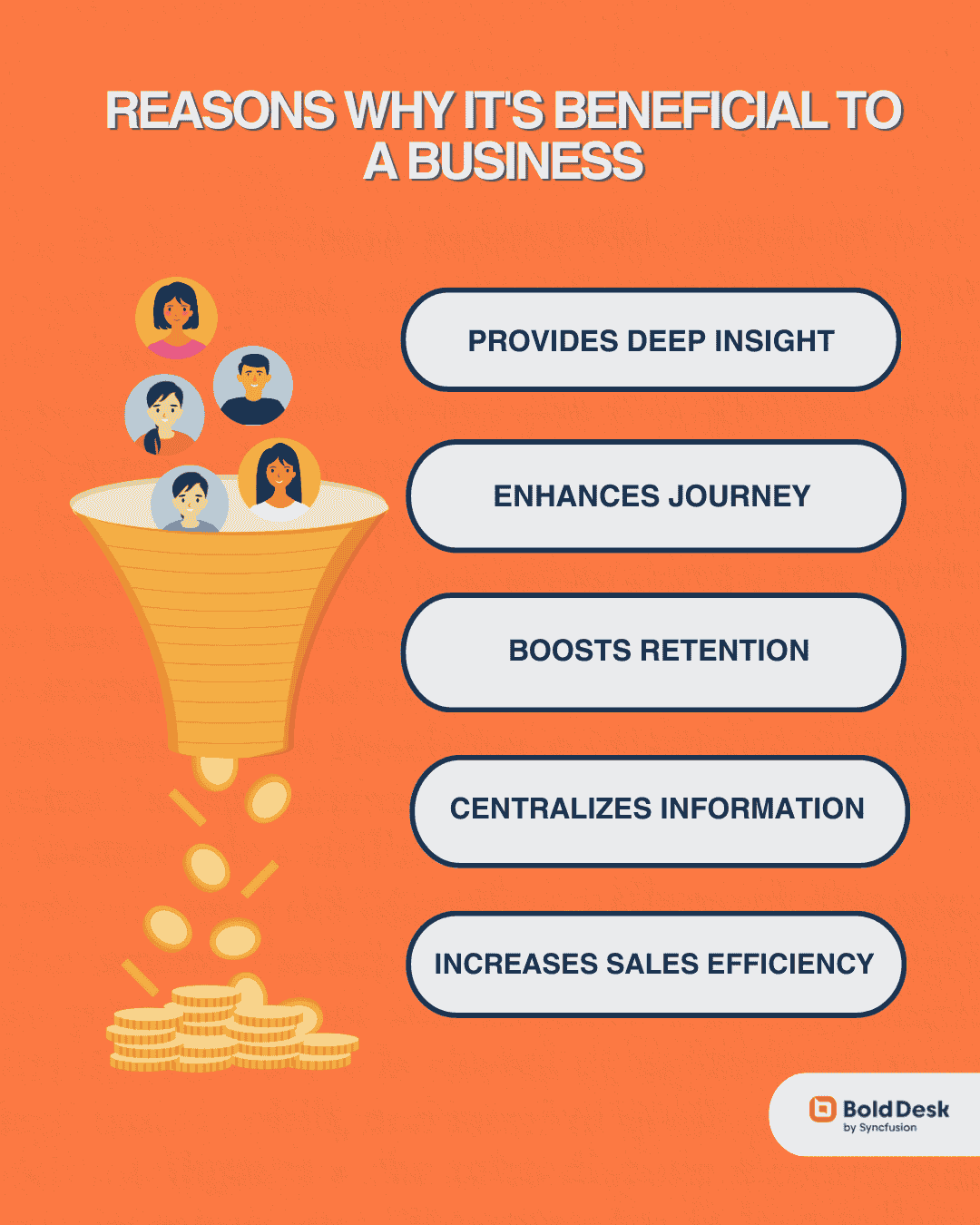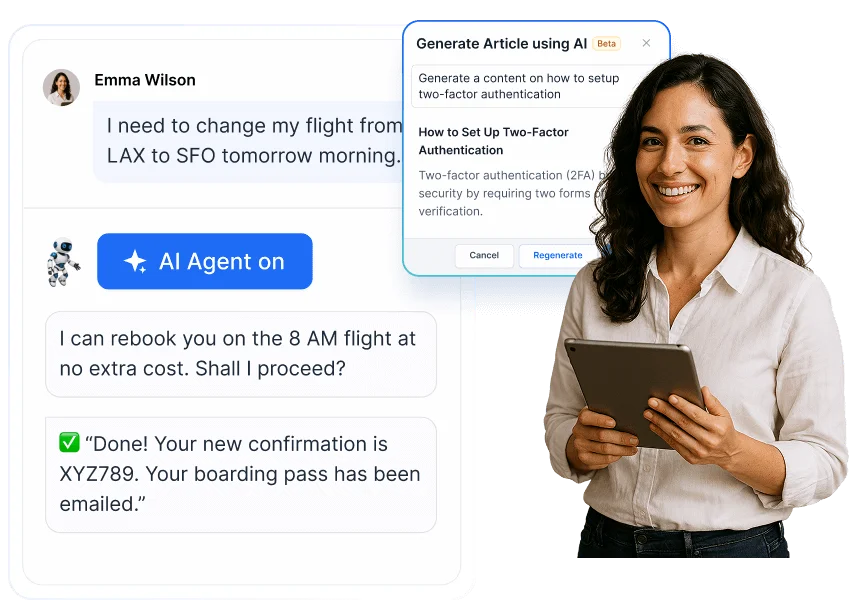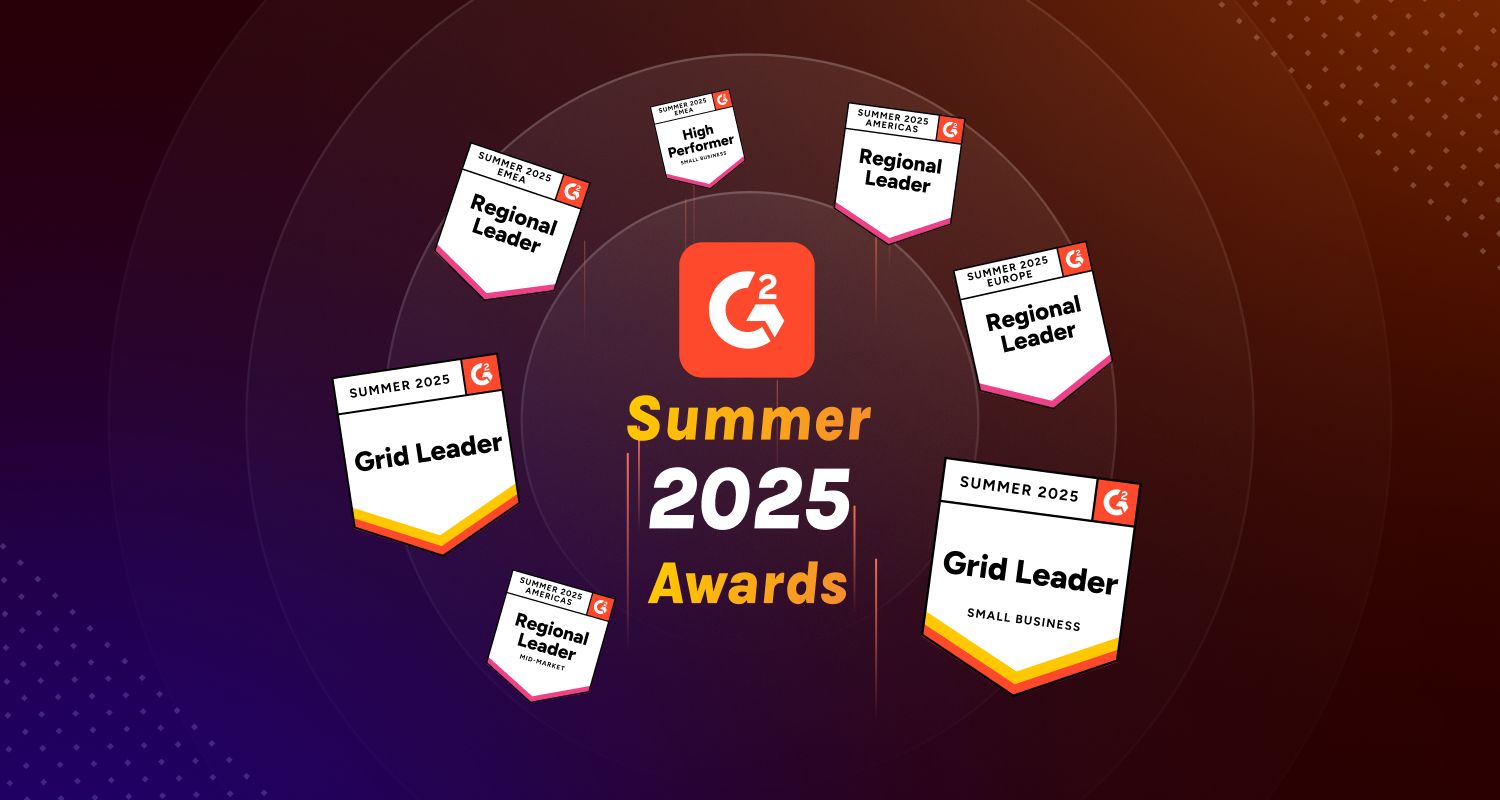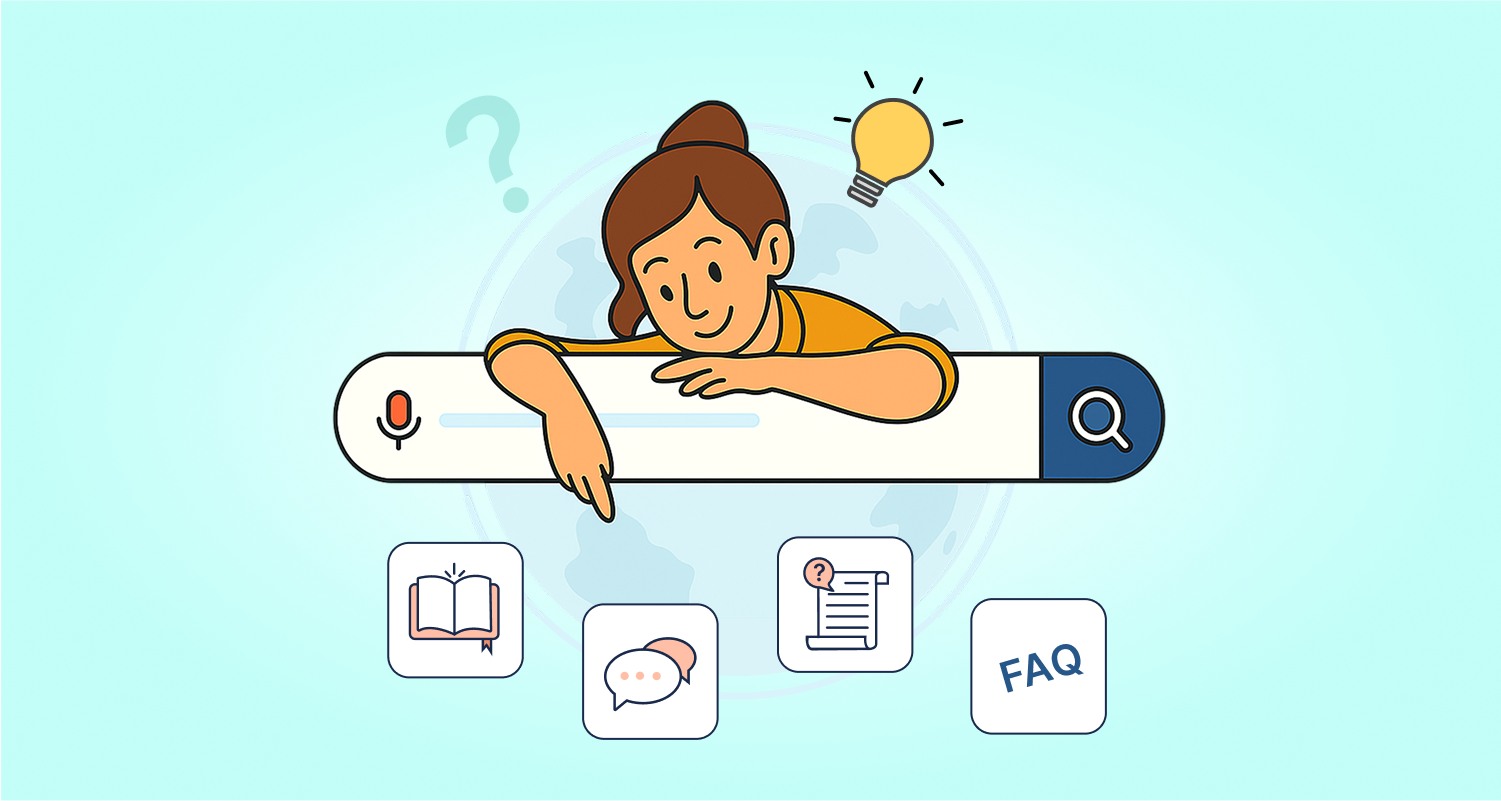Today, most customers expect businesses to provide them with personalized service. This expectation has made personalization crucial for businesses to survive and thrive in today’s competitive market.
The 360 customer view helps companies meet customer expectations using integrated, centralized customer data across various communication channels and platforms.
With a comprehensive 360-degree customer profile, businesses can better understand their customers across all interaction points, boosting personalization and retention.
Additionally, it improves decisions by giving deeper insights into customer behavior, preferences, and service history in real time.
This blog explains the comprehensive customer view, highlights its core components with practical examples, and shows why it matters to businesses.
Moreover, it describes how businesses utilize this practice to deliver smart service and engage with customers more strongly.
What is a 360 customer view?
A 360-degree customer view, often called a “360 customer view”, is a collection of all customer information gathered from various touchpoints across different departments within a business.
It covers basic information, purchases, support, behavioral patterns, involvement with marketing, and other data. By consolidating all customer data from various departments, businesses can eliminate data silos.
Because of this integrated view, teams are better equipped to learn about their customers’ likes, dislikes, and issues, ultimately leading to increased customer satisfaction and loyalty.
Key components of a 360-degree customer view
A complete customer insight is built by connecting various customer data sources, from their first contact to their most recent purchases or inquiries.
Each piece of information element adds value to the overall 360 customer profile, helping to build stronger relationships over time.
Here are the core components to consider:
| Data | Key Elements | Business Value |
| Basic demographics & contact | Name, age, location, contact details | Basic ID & targeting |
| Purchase data | Order history, payment method, and cart abandonment | Buying habits & loyalty |
| Support interactions | Tickets, chat logs, call records, and resolution times | Support needs & issues |
| Online behavior | Website visits, app usage, time on site | Digital intent & interests |
| Marketing campaigns | Email opens, ad clicks, promo code usage | Campaign engagement |
| Product usage | Login frequency, feature use, subscription status | Sentiment & feedback |
| Loyalty program activity | Points earned, reward preferences | Loyalty & reward tracking |
| Event participation | Webinars, workshops, and community activities | Event engagement |
| Referral information | Referrer details, referral program participation | Advocates & network |
By systematically collecting and integrating these key elements, businesses can move from scattered data points to a cohesive and actionable customer profile.
Why every business needs a 360-degree customer view: key benefits
Now that we understand the key components, you might wonder how they benefit a business.
Leveraging customer journey data from various sources aids businesses to grow efficiently in several ways:

Provides deep insight for informed decisions
Each customer interaction produces valuable data that can be combined into a holistic 360-degree view, yielding insights for informed decision-making.
By analyzing numerous interactions, businesses can detect emerging customer needs at an early stage.
According to a Microsoft survey, companies that use customer behavior analysis to uncover actionable insights achieve 85% higher sales growth than their competitors
Real-life example:
This enables informed content strategies that enhance individual customer experiences.
Besides that, it reveals potential problems that could impact groups of customers.
Not only that it uncovers untapped market opportunities and guides better product development based on real usage.
Enhances customer journey with personalization
A complete customer 360 view aids agents with instant access to relevant customer context, enabling individualized interactions at every touchpoint.
Here is a real-life example for better understanding:
According to a Forrester study, 82% of global B2B marketing decision-makers believe buyers expect personalized experiences. While 75% think that customers expect immediate responses to their questions.
Real-life example:
This approach significantly increases loyalty and improves customer satisfaction.
This allows them to greet customers by name and offer tailored solutions to customers. These tailored experiences make customers feel valued and recognized, encouraging loyalty and repeat business.
Boosts retention through proactive engagement
A 360-degree customer view helps companies see the full picture of their customers’ behavior.
This allows them to set up early warning systems that catch signs like reduced product use, more support requests, changing buying habits, or negative feedback.
A study by Bain & Company found that a 5% increase in retention rates can potentially boost profits by 25% to 95%.
By identifying and engaging at-risk customers early, businesses can strengthen customer retention and build lasting, loyal relationships.
Centralizes customer information across teams
Integrating customer data from various departments, such as marketing, sales, and support, provides a holistic 360-degree view of customers.
This aids agents in providing immediate information to customers and also ensures a seamless customer data transition between teams without losing important details.
It also enhances both agent and customer experience and facilitates better service to customers through a unified customer profile from various departments.
Increases marketing and sales efficiency
Common customer pain points and frequently asked features are turned into clear marketing messages to address concerns early.
Not only that, it enables sales teams to suggest products that are similar to customers’ needs.
Real-life example:
As a result, Amazon’s marketing and sales efforts are incredibly efficient, driving higher conversions and purchases.
The result is better targeting, increased conversion rates, higher sales, and a deeper understanding of market trends and customer preferences.
How to create a 360-degree customer view for your business
You have seen how important it is to have an all-around customer perspective for your business. Now, you should focus on building a customer profile.
Let’s start working on your 360-degree customer view or check if your existing 360-degree customer profile aligns with the following important steps.

1. Creating a centralized hub for customer data
Before you start collecting data, ensure you have a central place to store it.
Without a central system, customer information can get lost or remain siloed among different departments, making it difficult to see the big picture.
According to CDP, over three-quarters of companies (78%) use centralized data as part of their customer data strategy.
Consider these options based on your needs and existing infrastructure:
- Customer Data Platforms (CDPs): Purpose-built for creating unified customer profiles from multiple sources, with strong identity resolution capabilities
- Customer Relationship Management (CRM) Systems: Excellent for managing customer relationships and interactions, with growing data integration capabilities
- Data Management Platforms (DMPs): Strong in handling anonymous customer data and audience segmentation
- Enterprise Data Warehouses: Powerful for large-scale data storage and complex analytics requirements
The right platform will serve as your single source of truth for customer information, enabling all teams to work from consistent, up-to-date data.
2. Identify and gather all customer data sources
Once a system for collecting customer data is established, the next step involves gathering information from customer touchpoints across departments.
This process aims to create a comprehensive 360-degree view of each customer for effective management and strategic business decisions.
Ensuring that all relevant details are accurately captured is essential for improving customer management and aligning business strategies for success.
3. Enhancing existing customer data
Your existing customer data is just the beginning. It may be incomplete or outdated.
To build a truly accurate 360-degree customer view, you need to update and enhance this data regularly.
Here are some effective ways to do that:
- Social media analysis: Track brand-related comments, posts, mentions, hashtags, and customer sentiment in real-time. Consolidate all these interactions and user activities into a single dashboard for efficient data management.
- External data sources: Include market research, industry reports, and public datasets in your customer profiles. This broader context supports better segmentation and strategic planning.
- Customer feedback: Gather input through surveys, interviews, and feedback tools. This helps you understand customer motivations behind their actions.
- Behavioral analytics: Track how customers interact with your website or app. Tools like heatmaps and session recordings reveal hidden preferences and pain points.
Using these methods helps enhance your existing customer data, giving you more accurate profiles and enabling smarter engagement.
4. Ensure data integrity and refine the customer view
A successful 360-degree view relies on trustworthy, high-quality data, much like a skyscraper needs a solid foundation.
To keep all customer records consistent and accurate, focus on:
Data cleansing: Regularly check and fix any inaccurate or incomplete customer information, and set up automated checks that catch errors early. By doing this, your customer profiles stay clean and reliable.
Standardization: Create simple, consistent rules for entering and maintaining names, addresses, phone numbers, and other details. This will help keep your data neat and easy to use across all systems.
Deduplication & identity resolution: Use smart tools to spot and merge duplicate customer records. Connect different identifiers like email, phone, or cookie IDs to build one clear, complete profile for each customer.
A comprehensive 360-degree view of the customer should be updated regularly.
Businesses should continuously check, evaluate, and improve the unified customer profiles to ensure they remain effective.
| What to Check | What to Do |
| Speed of profile updates | Ensure new customer data appears in profiles promptly. |
| Profile reflects recent customer activity | Validate that profile information correctly reflects recent customer interactions. |
| Smooth system operation | Monitor for slow response times or data synchronization issues. |
| Correctness of behavioral tags/segments | Verify that customer segments and tags accurately reflect actual behavior. |
| Team usability of profiles | Survey internal users about profile usefulness and identify improvement areas. |
This ongoing maintenance ensures your customer insights remain sharp and actionable, empowering teams to support customers and build stronger relationships effectively.
Challenges in implementing a 360-degree customer view
While highly beneficial, creating a complete customer insight comes with challenges. Here’s how to tackle them:

Data silos
Customer information is often stored in separate systems across various departments, such as marketing, sales, and service.
These systems do not communicate effectively, making it challenging to create a unified view.
Solution: Implement a CDP or CRM to centralize data and integrate systems using APIs or iPaaS platforms. Establish clear data-sharing protocols and encourage cross-departmental collaboration through regular meetings and shared KPIs.
Data quality and consistency
Customer data can be inaccurate, incomplete, outdated, or formatted differently across various sources, requiring significant effort to clean and standardize.
Solution: Set up data validation rules at entry points and standardize formats across all systems. Schedule automated data cleansing processes and assign dedicated data stewards to maintain quality standards.
Technology integration
Integrating diverse systems (CRM, ERP, marketing automation, e-commerce platforms) involves technical complexity, compatibility issues, and potential performance impacts.
Solution: Prioritize high-impact integrations first and use APIs or middleware solutions for system connectivity. Document all integrations thoroughly and establish maintenance schedules to ensure long-term functionality.
Cost and resources
Implementing the necessary technology, training staff, and dedicating personnel to manage and analyze customer data requires significant investment.
Solution: Start with essential integrations and expand gradually using scalable cloud solutions. Train existing staff rather than hiring new personnel, and test platforms with free trials first. Measure ROI through improved customer retention and conversion rates.
Data privacy and compliance
Adhering to data privacy regulations like GDPR (Europe), CCPA (California), and industry-specific regulations adds complexity to data collection, storage, and usage.
Solution: Design systems with privacy-by-design principles. Create data inventories that track what data is collected and why. Ensure data is properly secured with encryption and access controls, and audit regularly.
Elevate your customer experience with a 360-customer view
Obtaining complete customer insight is essential for delivering meaningful experiences. When businesses unify data from every touchpoint, they can personalize interactions, make informed decisions, and foster lasting loyalty.
Tools like BoldDesk make this possible by turning every customer inquiry into a ticket, ensuring no message goes unnoticed.
It also streamlines customer data collection and management across multiple channels. With integrations to CRMs like HubSpot, Pipedrive, and Salesforce, BoldDesk gives your support team access to rich, centralized customer insights. Contact us to unlock the potential of your customer data and drive remarkable improvements in your business today!
Did you find this post about using customer data to drive better experiences? Share your thoughts in the comments section below!
Related article
- 9 Effective Customer Experience Optimization Strategies
- What is Customer Stickiness? How to Measure and Improve It
Frequently Asked Questions (FAQs)
A 360-customer view is valuable for businesses of all sizes. Small and mid-sized companies can leverage it to understand customer needs, deliver personalized service, improve retention, and make data-driven decisions.



















 Email Ticketing System
Email Ticketing System Shared Inbox Software
Shared Inbox Software Multi Brand Help Desk
Multi Brand Help Desk Internal Help Desk Software
Internal Help Desk Software Trouble Ticketing Software
Trouble Ticketing Software Mobile Help Desk
Mobile Help Desk 

















